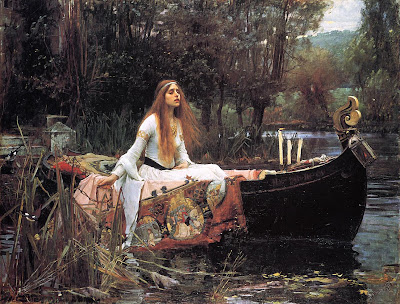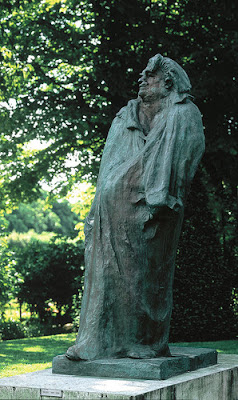Since she was found as a baby, floating
in the Thames one foggy night, the web-toed Pearl has been brought up in a
brothel known as the House of Mermaids. Cosseted and pampered there, it is only
when her fourteenth birthday approaches that Pearl realises she is to be sold
to the highest bidder.
Meanwhile, the orphaned twins, Lily and Elijah, have
shared an idyllic childhood, raised in a secluded country house with their
grandfather, Augustus Lamb. But when Lily and Elijah go on a visit to London, a
chance meeting with the ethereal Pearl will have repercussions for all of them,
binding their fates together in a dark and dangerous way...
In this bewitching,
sensual novel, Essie Fox has written another tale of obsessive love and
betrayal, moving from the respectable worlds of Victorian art and literature,
and into the shadowy demi-monde of brothels, asylums and freak show tents - a
world in which nothing and no-one is quite what they seem to be.
J.W. Waterhouse's Mermaid, 1900
"Will they find me again - those ghosts? Will they follow and watch when I walk on the water? Look! I am doing it now. You might think me mad to say such things but my thoughts are so clear as the beads of light that gleam on the stone of the obelisk, that sparkle like gems in bare branches of trees, so bright that I have to lift my hands to protect my eyes from the glare of the sun - the white jewel that has turned the whole wide world into this dreamland of ice and stone." Pearl
Elijah's Mermaid is broken up into four parts, with three young protagonists: Pearl, Elijah, and Lily taking turns telling their story. The setting is Victorian London. Essie Fox again, in this her second novel, proliferates each page with such realistic Victorian dialogue and an enchanting writing style the reader feels as if they are walking along Cheyne Walk in Chelsea when Pearl is found in The Thames and later on with The Lamb's at their residence, Kingsland House, Kingsland, Herefordshire, England around 1855.
Not only does Essie Fox know the Victorian era, she knows her Pre-Raphaelites as well; her passion leaps off every page. Some names are obvious i.e. Gabriel, Millais, and Rossetti mentioned but physical and descriptive hints could be found if you are familiar with such notables of The Pre-Raphaelite Brotherhood (Brethren) Indeed! It could just be me reading too much into it but grandfather of Lily and Elijah's Augustus Lamb was reminiscent of grandfather to his granddaughter and grandson Sir Edward Burne-Jones! Even The Lamb's loving glimpses of conversations between Lily and Augustus reminded me so much of Three Houses by Angela Thirkell!
Water is the primary element holding the basis of the story together for good reason which is later explained as the story of Pearl intertwines with Lily and Elijah once the story gets darker and more Gothic. Mermaid is in the title for specific reasons as Essie Fox first introduces the reader to a young woman found drowned in The Thames; then baby Pearl is discovered in 1850 and I just loved how she later describes herself, 'the bastard child saved by the river by Tip that night when my mother drowned herself for shame’ – who was brought up in a brothel by the rather whimsical name of The House of Mermaids. This was a ‘most prestigious Chelsea abode’, where the owner of the house, Mrs Hibbert, indulged the ‘every whim of those men wishing to use the brothel’s services.'
There are brothels, beautiful gardens and freak shows that appear as the story gets darker; more characters are there to 'guide' Lily and Elijah i.e. the absolutely horrible and hated Osbourne Black, the ever present Mrs. Hibbert and Uncle Frederick Hall etc. They are needed as numerous red herrings, twists, turns abound in this luscious Victorian Gothic tale. Pay attention and keep your wits about you for not everything is as it appears!
In closing, if you dear reader find yourself at a loss or just confused with these characters and their motives, fear not, for Essie Fox writes a helpful 'summation' of sorts at the end entitled, 'The Real Historical Characters Who Have Influenced Those In Elijah's Mermaid' along with a vocabulary list of Victorian Slang.
In fairness, I did not find much lacking in Elijah's Mermaid. I feel I must say something so any readers who are not used to reading Victorian era slang and 19th century dialogue might be put off or find themselves growing impatient. There are also numerous characters, London locations and places mentioned so again it might be off-putting. However, I revel in this sort of Victorian cultural and Gothic tale. I rarely find such a beautifully written one, as well.
I highly recommend Elijah's Mermaid by Essie Fox. This her second novel is even more entertaining and engaging than her first effort The Somnambulist, though, I loved it as well!
Elijah's Mermaid by Essie Fox is out now available in the United Kingdom. This was my purchase and not a free copy.
Please leave comments, I love hearing from you!
Not only does Essie Fox know the Victorian era, she knows her Pre-Raphaelites as well; her passion leaps off every page. Some names are obvious i.e. Gabriel, Millais, and Rossetti mentioned but physical and descriptive hints could be found if you are familiar with such notables of The Pre-Raphaelite Brotherhood (Brethren) Indeed! It could just be me reading too much into it but grandfather of Lily and Elijah's Augustus Lamb was reminiscent of grandfather to his granddaughter and grandson Sir Edward Burne-Jones! Even The Lamb's loving glimpses of conversations between Lily and Augustus reminded me so much of Three Houses by Angela Thirkell!
Water is the primary element holding the basis of the story together for good reason which is later explained as the story of Pearl intertwines with Lily and Elijah once the story gets darker and more Gothic. Mermaid is in the title for specific reasons as Essie Fox first introduces the reader to a young woman found drowned in The Thames; then baby Pearl is discovered in 1850 and I just loved how she later describes herself, 'the bastard child saved by the river by Tip that night when my mother drowned herself for shame’ – who was brought up in a brothel by the rather whimsical name of The House of Mermaids. This was a ‘most prestigious Chelsea abode’, where the owner of the house, Mrs Hibbert, indulged the ‘every whim of those men wishing to use the brothel’s services.'
There are brothels, beautiful gardens and freak shows that appear as the story gets darker; more characters are there to 'guide' Lily and Elijah i.e. the absolutely horrible and hated Osbourne Black, the ever present Mrs. Hibbert and Uncle Frederick Hall etc. They are needed as numerous red herrings, twists, turns abound in this luscious Victorian Gothic tale. Pay attention and keep your wits about you for not everything is as it appears!
In closing, if you dear reader find yourself at a loss or just confused with these characters and their motives, fear not, for Essie Fox writes a helpful 'summation' of sorts at the end entitled, 'The Real Historical Characters Who Have Influenced Those In Elijah's Mermaid' along with a vocabulary list of Victorian Slang.
In fairness, I did not find much lacking in Elijah's Mermaid. I feel I must say something so any readers who are not used to reading Victorian era slang and 19th century dialogue might be put off or find themselves growing impatient. There are also numerous characters, London locations and places mentioned so again it might be off-putting. However, I revel in this sort of Victorian cultural and Gothic tale. I rarely find such a beautifully written one, as well.
I highly recommend Elijah's Mermaid by Essie Fox. This her second novel is even more entertaining and engaging than her first effort The Somnambulist, though, I loved it as well!
Elijah's Mermaid by Essie Fox is out now available in the United Kingdom. This was my purchase and not a free copy.
Please leave comments, I love hearing from you!





































